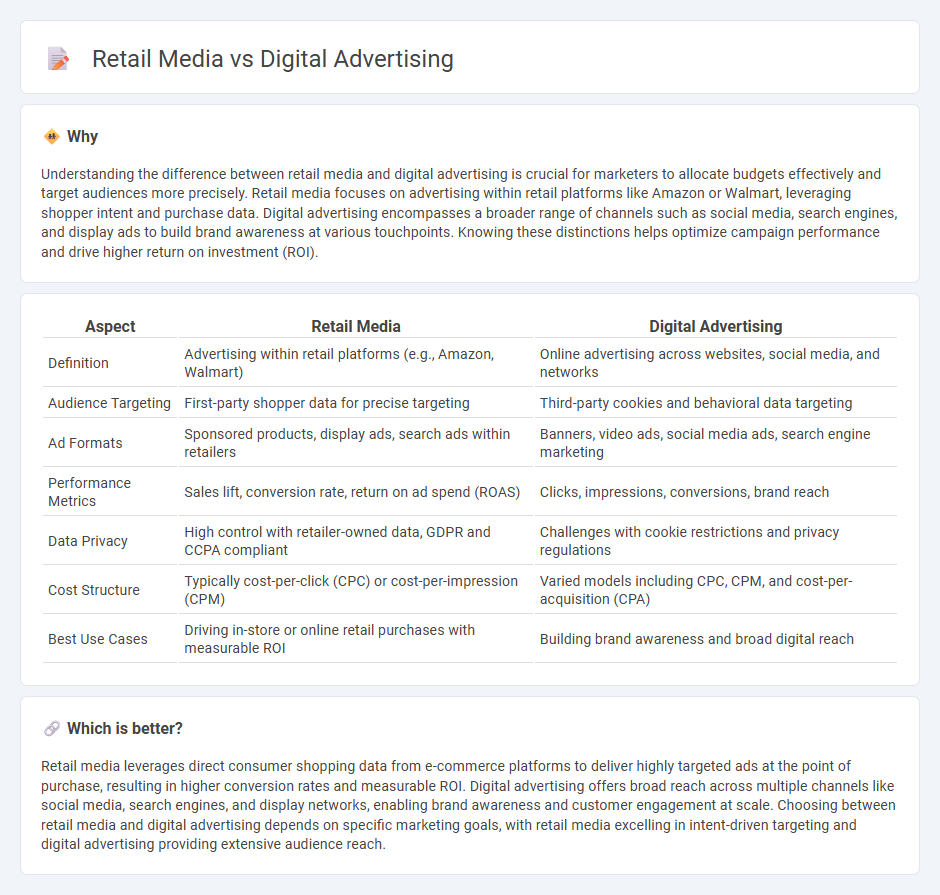
Retail media leverages retailer platforms and data to target consumers directly at the point of purchase, enhancing relevance and conversion rates. Digital advertising encompasses a broader range of online channels, including search engines, social media, and display networks, focusing on brand awareness and customer acquisition. Explore the differences between retail media and digital advertising to optimize your marketing strategy effectively.
Why it is important
Understanding the difference between retail media and digital advertising is crucial for marketers to allocate budgets effectively and target audiences more precisely. Retail media focuses on advertising within retail platforms like Amazon or Walmart, leveraging shopper intent and purchase data. Digital advertising encompasses a broader range of channels such as social media, search engines, and display ads to build brand awareness at various touchpoints. Knowing these distinctions helps optimize campaign performance and drive higher return on investment (ROI).
Comparison Table
| Aspect | Retail Media | Digital Advertising |
|---|---|---|
| Definition | Advertising within retail platforms (e.g., Amazon, Walmart) | Online advertising across websites, social media, and networks |
| Audience Targeting | First-party shopper data for precise targeting | Third-party cookies and behavioral data targeting |
| Ad Formats | Sponsored products, display ads, search ads within retailers | Banners, video ads, social media ads, search engine marketing |
| Performance Metrics | Sales lift, conversion rate, return on ad spend (ROAS) | Clicks, impressions, conversions, brand reach |
| Data Privacy | High control with retailer-owned data, GDPR and CCPA compliant | Challenges with cookie restrictions and privacy regulations |
| Cost Structure | Typically cost-per-click (CPC) or cost-per-impression (CPM) | Varied models including CPC, CPM, and cost-per-acquisition (CPA) |
| Best Use Cases | Driving in-store or online retail purchases with measurable ROI | Building brand awareness and broad digital reach |
Which is better?
Retail media leverages direct consumer shopping data from e-commerce platforms to deliver highly targeted ads at the point of purchase, resulting in higher conversion rates and measurable ROI. Digital advertising offers broad reach across multiple channels like social media, search engines, and display networks, enabling brand awareness and customer engagement at scale. Choosing between retail media and digital advertising depends on specific marketing goals, with retail media excelling in intent-driven targeting and digital advertising providing extensive audience reach.
Connection
Retail media leverages digital advertising by utilizing retailer-owned data and platforms to deliver targeted ads directly to consumers during their shopping journey. Digital advertising enables precise audience segmentation and real-time bidding, enhancing the effectiveness of retail media campaigns. The integration of retail media with digital advertising drives higher conversion rates and maximizes return on ad spend (ROAS) in e-commerce ecosystems.
Key Terms
Programmatic Advertising
Programmatic advertising leverages automated technology to buy and optimize digital ad space in real-time, enhancing targeting precision and campaign efficiency. Retail media focuses on monetizing e-commerce and retail platforms by integrating ads directly within the shopping environment, tapping into rich first-party consumer data. Explore how programmatic advertising and retail media collectively boost ROI and drive sales growth.
Shopper Data
Shopper data plays a pivotal role in both digital advertising and retail media, enabling precise audience targeting and personalized marketing strategies. Digital advertising leverages broad data sources to reach diverse online users, while retail media utilizes first-party shopper data from retail platforms for highly relevant and actionable insights. Explore how harnessing shopper data differentiates these channels and drives effective campaigns.
Attribution
Digital advertising leverages broad data sources and multi-channel tracking to attribute conversions and optimize campaign performance across platforms like search, social, and display networks. Retail media emphasizes first-party shopper data and on-site purchase behavior to provide precise attribution within e-commerce ecosystems such as Amazon, Walmart, or Target, enhancing ROI by directly linking ads to sales. Explore deeper into how these attribution models transform marketing strategies and drive better customer insights.
Source and External Links
Understanding Digital Advertising - NAI - Digital advertising is paid advertising on websites, apps, and smart TVs, often tailored to user interests like broad categories to provide relevant ads and support free online content and services.
What is digital advertising? 4 examples to use in your strategy - Digital advertising is the promotion of products or services via digital channels such as websites, social media, search engines, and apps, enabling companies to reach the large global audience online.
Digital advertising 101: beginner's guide to advertising online - Digital advertising starts with a research-backed campaign strategy targeting the right audience, choosing distribution channels, and creating engaging content to effectively promote a business online.
 dowidth.com
dowidth.com